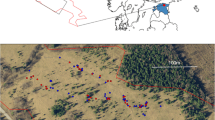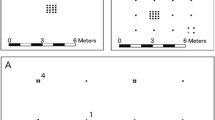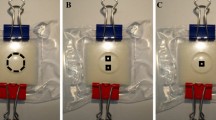Abstract
For parasitoids, host finding is a central problem that has been solved through a variety of behavioural mechanisms. Among species in which females do not make direct contact with hosts, as is the case for many dipteran parasitoids, eggs must be laid in an appropriate part of the host habitat. The asilid fly Mallophora ruficauda lays eggs in clusters on tall vegetation. Upon eclosion, pollen-sized larvae fall and parasitize soil-dwelling scarab beetle larvae. We hypothesized that wind dissemination of M. ruficauda larvae is important in the host-finding process and that females lay eggs at heights that maximize parasitism of its concealed host. Through numerical and analytical models resembling those used to describe seed and pollen wind dispersal, we estimated an optimal oviposition height in the 1.25- to 1.50-m range above the ground. Our models take into account host distribution, plant availability and the range over which parasitic larvae search for hosts. Supporting our findings, we found that the results of the models match heights at which egg clusters of M. ruficauda are found in the field. Generally, work on facilitation of host finding using plants focuses on plants as indicators of host presence. We present a case where plants are used in a different way, as a means of offspring dispersal. For parasitoids that carry out host searching at immature stages rather than as adults, plants are part of a dissemination mechanism of larvae that, as with minute seeds, uses wind and a set of simple rules of physics to increase offspring success.




Similar content being viewed by others
References
Adamo SA, Robert P, Perez J, Hoy RR (1995) The response of an insect parasitoid, Ormia ochracea (Tachinidae), to the uncertainty of larval success during infestation. Behav Ecol Sociobiol 36:111–118
Adamovic ZR (1974) Copulation and oviposition of Dysmachus hradskyi Adamovic (Diptera: Asilidae). Bull Mus Hist Nat Beograd B 29:45–49
Alcock J (1974) Observations on the behavior of Mallophora fautrix Osten Sacken (Diptera: Asilidae). Pan-Pac Entomol 50:68–72
Andersen M (1991) Mechanistic models for the seed shadows of wind-dispersed plants. Am Nat 137(4):476–497
de Boer JD, Snoeren TAL, Dicke M (2005) Predatory mites learn to discriminate between plant volatiles induced by prey and nonprey herbivores. Anim Behav 69:869–879
Bullock JM, Clarke RT (2000) Long distance seed dispersal by wind: measuring and modelling the tail of the curve. Oecologia 124:506–521
Campan E, Benrey B (2004) Behavior and performance of a specialist and a generalist parasitoid of bruchids on wild and cultivated beans. Biol Control 30:220–228
Castelo MK (2003) Comportamiento de localización y patrones de explotación de hospedadores (Coleoptera: Scarabaeidae) por el moscardón cazador de abejas Mallophora ruficauda (Diptera: Asilidae). Ph.D. dissertation, University of Buenos Aires, Buenos Aires, Argentina
Castelo MK, Capurro AF (2000) Especificidad y denso-dependencia inversa en parasitoides con oviposición fuera del hospedador: el caso de Mallophora ruficauda (Diptera: Asilidae) en la Pampa Argentina. Ecol Austral 10(1):89–101
Castelo MK, Corley JC (2004) Oviposition behaviour in the robber fly Mallophora ruficauda (Diptera: Asilidae). Ann Entomol Soc Am 97(5):1050–1054
Castelo MK, Lazzari CR (2004) Host seeking behavior in larvae of the robber fly Mallophora ruficauda (Diptera: Asilidae). J Insect Physiol 50(4):331–336
Clark JS, Silman M, Kern R, Macklin E, Lambers JHR (1999) Seed dispersal near and far: patterns across temperate and tropical forests. Ecology 80:1475–1494
Clements AN, Bennett FD (1969) The structure and biology of a new species of Mallophora Macq. (Diptera: Asilidae) from Trinidad. B Entomol Res 58(3):455–463
Copello A (1922) Biología del moscardón cazador de abejas (Mallophora ruficauda Wied). Physis 6:30–42
Cortesero AM, Stapel JO, Lewis WJ (2000) Understanding and manipulating plant attributes to enhance biological control. Biol Control 17:35–49
Czajkowski JD, Rosenfeld E (1992) Regionalización bioclimática de la provincia de Buenos Aires. In: Actas 15a Reunión de ASADES (Asoc. Arg. Energía Solar), Catamarca, Catamarca, Argentina http://jdczajko.tripod.com/publicaciones/asades92/regclim.htm)
Dennis DS, Lavigne RJ (1975) Comparative behavior of Wyoming robber flies II (Diptera: Asilidae). University of Wyoming Agricultural Experiment Station Science Monograph 30, 68 pp
Eggleton P, Belshaw R (1993) Comparisons of dipteran, hymenopteran and coleopteran parasitoids: provisional phylogenetic explanations. Biol J Linn Soc 48:213–226
Feener Jr DH, Brown BV (1997) Diptera as parasitoids. Annu Rev Entomol 42:73–97
Feener Jr DH, Jacobs LF, Schmidt JO (1996) Specialized parasitoid attracted to a pheromone of ants. Anim Behav 51:61–66
Fletcher JP, Hughes JP, Harvey IF (1994) Life expectancy and egg load affect oviposition decisions of a solitary parasitoid. Proc R Soc Lond B Biol Sci 258:163–167
Fournet S, Poinsot D, Brunel E, Nénon JP, Cortesero AM (2001) Do female coleopteran parasitoids enhance their reproductive success by selecting high-placing oviposition sites? J Anim Ecol 70:1046–1052
Godfray HCJ (1994) Parasitoids: behavior and evolutionary ecology. Princeton University Press, Princeton, New Jersey
Greene DF, Johnson EA (1989) A model of wind dispersal of winged or plumed seeds. Ecology 70(2):339–347
Greene DF, Johnson EA (1996) Wind dispersal of seeds from a forest into a clearing. Ecology 77:595–609
Greene DF, Johnson EA (1997) Secondary dispersal of tree seeds on snow. J Ecol 85(3):329–340
Guries RP, Nordheim EV (1984) Flight characteristics and dispersal potential of maple samaras. Forest Sci 30:434–440
Hagen KS (1964) Developmental stages of parasites. In: DeBach P (ed) Biological control of insect pests and weeds. Reinhold, New York, pp 168–246
Hardy GH (1929) Revisional notes on described Australian robber flies of the genus Ommatius (Asilidae). Proc R Soc Queensl 40(6):61–65
Harris VE, Todd JW (1980) Male-mediated aggregation of male, female, and 5th-instar southern green stink bugs and concomitant attraction of a tachinid parasite, Tricopoda pennipes. Entomol Exp Appl 27:117–126
Heimpel GE, Mangel M, Rosenheim JA (1998) Effects of time limitation and egg limitation on lifetime reproductive success of a parasitoid in the field. Am Nat 152:273–289
Johnson WC, Sharpe DM, DeAngelis DL, Fields DE, Olson RJ (1981) Modeling seed dispersal and forest island landscapes. In: Burgess L, Sharpe DM (eds) Forest island dynamics in man-dominated landscapes. Springer, Berlin Heidelberg New York, pp 215–239
Katul GG, Porporato A, Nathan R, Siqueira M, Soons MB, Poggi D, Horn HS, Levin SA (2005) Mechanistic analytical models for long-distance seed dispersal by wind. Am Nat 166(3):368–381
Kershaw JC (1912) The ootheca of an Asilid. J Bombay Nat Hist Soc 21:610–613
Lawson FA, Lavigne RJ (1984) Oviposition and eggs of an Australian robber fly, Neoaratus abludo Daniels (Diptera: Asilidae). Proc Entomol Soc Wash 86(4):773–776
Linsley EG (1960) Ethology of some bee- and wasp-killing robber flies of southeastern Arizona and western New Mexico (Diptera: Asilidae). Univ Calif Publ Entomol 16:357–392
Londt JGH (1994) Afrotropical Asilidae (Diptera) 26. Ethological observations, and a possible ecological classification based on habitats. Ann Natal Mus 35:97–122
Mangel M (1989) An evolutionary interpretation of the “motivation to oviposit”. J Evol Biol 2:157–172
Musso JJ (1978) Recherches sur le développement, la nutrition et l’écologie des Asilidae (Diptera-Brachycera). Ph.D. dissertation, Université de Droit, d’Economie et des Sciences d’Aix-Marseille, Marseille, France
Musso JJ (1981) Morphology and development of the immature stages of some robber flies (Diptera: Brachycera: Asilidae). Entomol Gen 7(1):89–104
Musso JJ (1983) Nutritive and ecological requirements of robber flies (Diptera: Brachycera: Asilidae). Entomol Gen 9 (1/2):35–50
Musso JJ, Garcin J (1975) Recherches préliminaires sur le régime alimentaire des larves d’asilides (Diptera: Brachycera). Bull Soc Zool Fr 100(3):313–322
Nathan R, Katul GG (2005) Foliage shedding in deciduous forests lifts up long-distance seed dispersal by wind. Proc Natl Acad Sci USA 102(23):8251–8256
Nathan R, Safriel UN, Noy-Meir I, Schiller G (1996) Samara’s aerodynamic properties in Pinus halepensis Mill., a colonizing tree species, remain constant despite considerable variation in morphology. In: Steinberger Y (ed) Preservation of our world in the wake of change. Israel Society for Ecology & Environmental Quality Sciences, Jerusalem, pp 553–556
Nathan R, Safriel UN, Noy-Meir I (2001a). Field validation and sensitivity analysis of a mechanistic model for the tree seed dispersal by wind. Ecology 82(2):374–388
Nathan R, Horn HS, Chave J, Levin SA (2001b). Mechanistic models for tree seed dispersal by wind in dense forests and open landscapes. In: Levey DJ, Silva WR, Galetti M (eds) Seed dispersal and frugivory: ecology, evolution and conservation. CAB, Oxfordshire, 16 pp
Nathan R, Katul GG, Horn HS, Thomas SM, Oren R, Avissar R, Pacala SW, Levin SA (2002) Mechanisms of long-distance dispersal of seeds by wind. Nature 418(6896):409–413
Nurminiemi M, Tufto J, Nilsson N, Rognli OA (1998) Spatial models of pollen dispersal in the forage grass meadow fescue. Evol Ecol 12:487–502
Nuttle T (2005) Seed dispersal in heterogeneous environments: bridging the gap between mechanistic dispersal and forest dynamics models. Am Nat 165(3):336–349
Okubo A (1980) Diffusion and ecological problems: mathematical models. Springer, Berlin Heidelberg New York
Okubo A, Levin S (1989) A theoretical framework for data analysis of wind dispersal of seed and pollen. Ecology 70(2):329–338
Pennanen J, Greene DF, Fontin MJ, Messier C (2004) Spatially explicit simulation of long-term boreal forest landscape dynamics: incorporating quantitative stand attributes. Ecol Model 180:195–209
Reinhard EG (1938) The egg-laying and early stages of the robber fly Erax aestuans (Diptera: Asilidae). Entomol News 49:281–283
Roitberg BD, Mangel M, Lalonde RG, Roitberg CA, van Alphen JJM, Vet L (1992) Seasonal dynamic shifts in patch exploitation by parasitic wasps. Behav Ecol 3:156–165
Roitberg BD, Sircom J, Roitberg CA, van Alphen JJM, Mangel M (1993) Life expectancy and reproduction. Nature 364:108
Schippers P, Jongejans E (2005) Release thresholds strongly determine the range of seed dispersal by wind. Ecol Model 185:93–103
Sharpe DM, Fields DE (1982) Integrating the effects of climate and seed fall velocities on seed dispersal by wind: a model and application. Ecol Model 17:297–310
Sirot E, Ploye H, Bernstein C (1997) State dependent superparasitism in a solitary parasitoid: egg load and survival. Behav Ecol 8:226–232
Stephens DW, Krebs JR (1986) Foraging theory. Princeton University Press, Princeton, New Jersey
Stubbs AE (1970) Observations on the oviposition of Leptarthus brevirostris (Mg.) (Diptera: Asilidae). Entomologist 103(1291):289–293
Takabayashi J, Sato Y, Horikoshi M, Yamaoka R, Yano S, Ohsaki N, Dicke M (1998) Plant effects on parasitoid foraging: differences between two tritrophic systems. Biol Control 11:97–103
Vet LEM, Lewis WJ, Cardé RT (1995) Parasitoid foraging and learning. In: Cardé RT, Bell WJ (eds) Chemical ecology of insectzs 2. Chapman and Hall, New York, pp 65–101
Vet LEM, Hemerik L, Visser ME, Wäkers FE (2002) Flexibility in host-search and patch-use strategies in insect parasitoids. In: Lewis EE, Campbell JF, Sukhdeo MVK (eds) The behavioural ecology of parasites. CAB, Oxfordshire, pp 39–64
Vinson SB (1976) Host selection by insect parasitoids. Annu Rev Entomol 21:109–133
Vinson SB (1984) How parasitoids locate their host: a case of insect espionage. In: Lewis T (ed) Insect communication. Academic, London, pp 325–348
Vinson SB (1998) The general host selection behaviour of parasitoid Hymenoptera and a comparison of initial strategies utilized by larvaphagous and oophagous species. Biol Control 11:79–96
Wagner S, Wälder K, Ribbens E, Zeibig A (2004) Directionality in fruit dispersal models for anemochorous forest trees. Ecol Model 179:487–498
Xie HY, Zhang DW (2001) Stokes shape factor and its application in the measurement of spherity of non-spherical particles. Powder Technol 114:102–105
Acknowledgements
This work was carried out during an exchange programme between France and Argentina supported by the SECyT-ECOS-SUD Programme (grants A98B05 and A04B02). We also acknowledge support from CONICET (post-doctoral fellowship to M. Castelo, PIP 0529/98 and Subsidio a Investigadores Resol. 680 to J. Corley) and ANPCyT (grant PICT 01-16724 to M. Castelo). We thank Federico Hanssen for helping in the design of the simulation model. Two anonymous referees, Saskya van Nouhuys, Emmanuel Desouhant and Juan Carlos Reboreda critically read the manuscript, providing excellent advice. The experiments comply with the current laws of Argentina.
Author information
Authors and Affiliations
Corresponding author
Additional information
Communicated by: H. Kokko
Appendices
Appendix A
The number of hosts parasitized by larvae issued from a single egg cluster is derived in two steps. First, the distribution of larvae on the ground after release from the plant is calculated, and then the number of host parasitized is evaluated.
A basic mechanistic model of seed dispersion by wind shows that the horizontal distance (x) a seed (here a larva) can travel by the wind is a linear function of the height of release (h), the mean horizontal wind speed during larvae flight (u) and the terminal velocity (T) (Grenne and Johnson 1989, 1996; Nathan et al. 1996, 2001a,b).
T is the falling velocity reached by the larvae shortly after release; this quantity depends on the characteristics of the larva (shape and weight).
Here, we further assume that the larvae are uniformly distributed within the shadow (the area that encompasses all the larvae after landing on the ground, see text). This shadow is a sector whose bisecting line length is given by Eq. 2 with u=U, the maximum wind speed the larvae experience during their drop.
Assuming random encounters between hosts and parasitoids, the probability that r larvae parasitize a given host is given by a Poisson distribution. The parameter of this distribution, the mean number of larvae per unit area, is given by
where Q is the number of larvae in the cluster and a(h) is the non-isotropic shadow area (see text). The shadow being a sector of angle 2θ (θ takes values between 0 and π) and radius Uh/T, one gets
Finally, the number of hosts parasitized by the Q larvae is the number of hosts present in the ground within the shadow (with density p), weighted by the probability that each host is found by at least one larva
Similarly, the number of hosts superparasitized is given by the probability that each host is found by at least two larvae,
To take into account the possible heterogeneity in host distribution, we substitute the Poisson distribution, by the negative binomial distribution (see discussion on aggregation in host distribution in the main text). The probability of a given host being found by at least one larva becomes
where k is the shape parameters of the negative binomial distribution. As k departs from 0 and becomes larger, the host distribution becomes less aggregated, and at the limit \( k \to + \infty \) one recovers the Poisson distribution. The second parameter of the negative binomial distribution is its mean, here equal to λ (see Eq. 3).
Appendix B
Numerical simulation model
Larvae dispersal was simulated by means of a spatially explicit model, using a grid of 200×200 cells, each cell representing an area of 400 cm2. The grid represents the soil surface where the larvae drop, and contains only one egg cluster at variable height, placed in the centre of the grid (oviposition site). Hosts are distributed in patches of variable size of constant density (1,600 hosts per grid on average).
Larvae are dislodged from the oviposition site and can fall in any cell, depending on the dispersal direction and the distance travelled (x). Dispersal direction is fixed and it is assumed constant during the larvae falling. Travel distance, the horizontal distance covered by a larva while dropping, is given by Eq. 2 with u=U′, where U′ is the mean horizontal wind velocity during the falling of the larvae and T is the terminal velocity of one larva that falls without wind. Terminal velocity depends of both the size and weight of the particle and the fluid in which it displaces (Okubo 1980). Host distribution inside patches is modelled through a cell occupation probability. Density in each patch is assigned by means of an occupation probability, which by default is set at 50% on average. The wind spreads the larvae in the grid at random with given angle spans and degrees of variation in intensity, leading to a cone-shaped dispersion pattern (Nathan et al. 2001a; Wagner et al. 2004).
The definition and numerical values of the physical and biological parameters of the model related to the movement of larvae are given in Table 1 (see main text).
With this model, for each height of egg laying, we simulated different host distributions changing parameter values (a “grid”). A total of 90 grids were considered for each height, and 100 larvae falling cycles (100 egg clusters) were simulated for each grid. We thus obtained a total 9,000 cycles per oviposition height. We considered 16 height values, from 0 to 4 m, in intervals of 0.10 m.
We assumed the following: the larval drop is uniform due to its terminal velocity; the larva reaches quickly the terminal velocity after its release from the egg cluster, so that travelled vertical distance is negligible; there are no interactions or turbulence during the drop process; each cell may be only occupied by a single host and all larvae falling on an occupied cell will parasitize or superparasitize; and dispersal direction is randomly defined.
Appendix C
The oviposition strategy is defined by the probabilities p i of choosing each type-i plant upon encounter. This strategy is obtained by maximizing the rate of fitness gain (fitness over time), which comes from calculating the following (Stephens and Krebs 1986):
One can show that p j is either 0 or 1, the latter occurring if
This leads to the guess that higher plants are better since the fitness they allow is larger. This can be proven by recurrence, and one can derive a procedure for choosing the optimal plants (Stephens and Krebs 1986). Finally, the optimal oviposition strategy consists of accepting taller plants, those whose type j is larger or equal to i*. The threshold i* is the smallest j such that inequality (Eq. 1) in text, derived from Eq. 9, is verified.
Rights and permissions
About this article
Cite this article
Castelo, M.K., Ney-Nifle, M., Corley, J.C. et al. Oviposition height increases parasitism success by the robber fly Mallophora ruficauda (Diptera: Asilidae). Behav Ecol Sociobiol 61, 231–243 (2006). https://doi.org/10.1007/s00265-006-0254-5
Received:
Revised:
Accepted:
Published:
Issue Date:
DOI: https://doi.org/10.1007/s00265-006-0254-5




